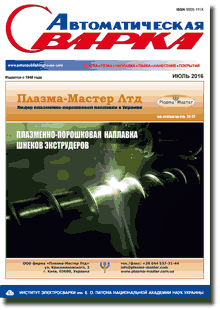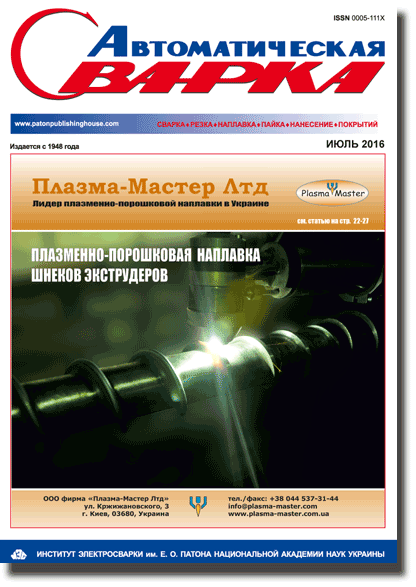| 2016 №07 (04) |
DOI of Article 10.15407/as2016.07.05 |
2016 №07 (06) |

Avtomaticheskaya Svarka (Automatic Welding), #7, 2016, pp. 28-34
Technological capabilities of vibration treatment of welded structures (Review)
G.I. Lashchenko
E.O. Paton Electric Welding Institute, NASU 11 Kazimir Malevich Str., 03680, Kiev, Ukraine. E-mail: office@paton.kiev.ua
Abstract
Analysis of technological capabilities of postweld vibration treatment and vibration treatment during welding was performed on the basis of available publications. It is shown that the technology of postweld vibration treatment is an effective means of lowering residual stresses and increasing dimensional stability of beam, frame and casing structures (machine-tool construction, mechanical engineering, shipbuilding, etc.) made of steel, titanium and aluminium alloys. Compared to high tempering, power consumption is reduced tens of times and productivity is increased. Vibration treatment during welding and surfacing is an effective means of lowering residual stresses, increasing mechanical properties and performance of structures, and improving weldability of a number of steel grades. However, experience of industrial application of this technology is so far insufficient for formulating clear recommendations on specific fields of its application. 41 Ref., 3 Figures.
Keywords: welded structures, residual stresses, vibration treatment, dimensional instability, increased fatigue resistance, weldability
Received: 11.03.16
Published: 02.08.16
References
- (1993) Welded building structures. Vol. 1: Principles of structure design. Ed. by L.M. Lobanov. Kiev: Naukova Dumka.
- Lashchenko, G.I., Demchenko, Yu.V. (2008) Energy-saving technologies of postweld treatment of metal structures. Kiev: Ekotekhnologiya.
- Pisarenko, V.S., Verzhbinskaya, N.I. (1972) Decrease of residual stresses by vibration treatment (Review). Moscow: NII Informtyazhmash.
- Gruzd, A.A. (1973) Examination of welded structure deformations in time and searching for methods for their accounting and stabilizing. Kiev: PWI.
- Sagalevich, V.M. (1974) Methods of elimination of welding strains and stresses. Moscow: Mashinostroenie.
- Sagalevich, V.M., Saveliev, V.F. (1986) Stability of welded joints and structures. Moscow: Mashinostroenie.
- Dawson, R., Moffat, D.G. (1980) Vibration stress relief. In: of ASM on Theor. Principles of Eng. Calculations, 2, 1–9.
- Ragulskis, K.M., Stupilnas, B.B., Tolutas, K.B. (1987) Vibration ageing. Leningrad: Mashinostroenie.
- Sedek, P. (1990) Stabilisacja wibracyjna konstrukcji spawanych. Przeglad Spawalnictwa, 7, 16–18.
- Lashchenko, G.I. (2001) Vibration treatment of welded structures. Kiev: Ekotekhnologiya.
- Gorbach, V.D., Sokolov, O.G., Mikhajlov, V.S. (2003) Problems of welding and fatigue life of welded structures in shipbuilding. The Paton Welding J., 10/11, 158–163.
- Dryga, A.I. (2004) Vibrostabilizing treatment of welded and cast parts in machine-building (theory, studies, technology). Kramatorsk: DGMA.
- Xhou Wei, Chen Hui (2012) Study of possibility for decrease of stresses in joints from steel SWA490BW resistant to atmosphere corrosion using vibration treatment. Dian Hanji-Elec. Welding Mach., 9, 62–65.
- Babichev, A.P., Butenko, V.I., Chukarin, A.N. et al. (2014) Improvement of resistance of welded joints. Tekhnologii i Pokrytiya, 6, 3–6.
- Degtyaryov, V.A. (2013) Effect of strengthening treatment of welded joints on increase of their fatigue resistance. Problemy Prochnosti, 5, 85–103.
- Grigoriants, A.G., Shiganov, I.N., Misyurov, A.I. et al. (2014) Technologies of low-frequency vibrotreatment of welded joints in machine-building. Proizvodstvo, 6, 19–23.
- Rao, D., Wang, D., Chen, L. et al. (2007) The effectiveness evaluation of 314L stainless steel vibratory stress relief by dynamic stress. J. Fatigue, 29. https://doi.org/10.1016/j.ijfatigue.2006.02.047
- Zhao, X.C., Zhang, Y.D., Zhang, H.W. et al. (2008) Simulation of vibration stress relief after welding based on FEM. Acta Metall. Sin., 21(21). https://doi.org/10.1016/s1006-7191(08)60051-4
- Sedek, P., Welzel, M., Kwiecinski, K. (2016) Stabilizazja wibrayjna – staly rozwoj dla praktyki przemyslowej. Inst.Spawalnictwa, 1, 29–35.
- Yang, Y.P., Jung, C., Yancey, R. (2005) Finite element modeling of vibration stress relief after welding. In: of 7th Conf. on Trends in Welding Research (USA, May 16–20, 2005).
- Klauba, B.B., Adams, C.M., Berry, J.T. (2005) Vibratory stress relief: Methods used to monitor and document effective treatment. A survey of users and directions for further research. Ibid.
- Filippov, Yu.A., Amelchenko, N.A., Ruchkin, L.V. et al. (2002) Theoretical aspects of ageing vibrotechnologies of non-standard equipment welded bodies. Tekhnologiya Mashinostroeniya, 4, 33–35.
- Karetnikov, V.D., Rizvanov, R.G., Fajrushin, A.I. et al. (2014) Increase in reliability of gas-oil equipment operating under conditions of abrupt thermal gradient. Ibid., 4, 33–37.
- Abdullin, T.Z., Ibragimov, I.G., Fajrushin, A.M. (2013) Study of vibration treatment effect during welding on mechanical properties of welded joints. Svarka i Diagnostika, 1, 36–38.
- Abdullin, T.Z. (2013) Improvement of technology for production of welding equipment from heat-resistant steel 12MKh: Syn. of Thesis for Cand. of Techn. Sci. Degree. Ufa: UfaGNTU.
- Fajrushin, A.M., Karetnikov, D.V., Zaritov, M.Z. et al. Method of residual stress relaxation in welded joints of metals. Pat. 2424885 Russia. Publ. 27.07.2011.
- Bolotov, V.I., Khafizov, O.F., Fajrushin, A.M. et al. Method of residual stress relaxation in welded joints of pipelines. Pat. 2492037 Russia. Publ. 10.09.2013.
- Akhtyamov, R.M., Ibragimov, I.G., Zaripov, M.Z. et al. (2013) Increase in strength of 12Kh18N10T steel welded joints using low-frequency vibration treatment during welding. Tekhnologii i Pokrytiya, 1, 38–41.
- Akhtyamov, R.M., Zaripov, M.Z., Fajrushin, A.M. (2012) Increase in strength of welded joints of two-layer 09G2S+12Kh18N10T steel using low-frequency vibration treatment during welding. In: of 5th Sci.-Pract. Conf. on Engineering and Tekhnology. New Prospects of Development (Moscow, 18 Apr. 2012), 8.
- Nuradinov, A.S., Efimov, V.A., Taranov, E.D. et al. (2004) Effect of vibration on formation of macro- and microstructure of solidified steel ingots. Materialovedenie, 5, 24–26.
- Lashchenko, G.I. (2006) Methods of consumable electrode arc welding. Kiev: Ekotekhnologiya.
- Nuradinov, A.S., Eldarkhanov, A.S., Taranov, E.D. (2012) Effect of vibration on residual stresses in ingots and welds. Stal, 4, 19–20.
- Pulka, Ch.V., Shably, O.N., Senchishin, V.S. et al. (2012) Influence of vibration of parts on structure and properties of metal in surfacing. The Paton Welding J., 1, 23–25.
- Shably, O.N., Pulka, Ch.V., Senchishin, V.S. Method of surfacing of thin flat steel parts. Pat. on ut. mod. UA 54204. Int. Cl. B23K 13/00. Publ. 25.10.2010.
- Pulka, Ch.V., Senchishin, V.S. Device for surfacing of thin shaped discs. Pat. on ut. mod. UA 59994. Int. Cl. B23K 13/00. Publ. 10.06.2011.
- Pulka, Ch.V., Senchishin, V.S. Method of surfacing of parts. Pat. on ut. mod. UA 64371. Int. Cl. B23K 13/00. Publ. 10.11.2011.
- Fajzulin, A.V., Madretdinov, A.I., Karetnikov, V.D. (2012) Repair welding of pump body made from medium-alloy steel 20KhGSFL. In: of 13th Int. Severgeoeko Junior Sci. Conf. (Ukhta, 21–23 March 2012), Pt 6, 70–72.
- Rizvanov, R.G., Fajrushin, A.M., Karetnikov, D.V. (2013) Study of influence of vibration treatment on mechanical properties and crack resistance of pipe welded joints from heat-resistant steel 15Kh5M. Delo, 1, 369–382.
- Khalimov, D.N., Samigushin, V.V., Fajrushin, A.M. (2013) Study of influence of vibration treatment in welding on mechanical properties of steel 12Kh17 welded joint. In: of 64th Sci.-Techn. Conf. of Students, Post-Graduates, Young Scientists of UfaGNTU (Ufa, Russia, 2013), Book 1, 234.
- Lobanov, L.M., Poznyakov, V.D., Makhnenko, O.V. (2013) Formation of cold cracks in welded joints from high-strength steels with 350–850 MPa yield strength. The Paton Welding J., 7, 7–12.
- Pokhodnya, I.K., Ignatenko, A.V., Paltsevich, A.P. et al. (2013) Hydrogen-induced cold cracks in welded joints of high-strength low-alloyed steels (Review). Ibid., 5, 2–13.
The cost of subscription/purchase order journals or individual articles
| Journal/Currency | Annual Set | 1 issue printed |
1 issue |
one article |
| TPWJ/USD | 384 $ | 32 $ | 26 $ | 13 $ |
| TPWJ/EUR | 348 € | 29 € | 24 € | 12 € |
| TPWJ/UAH | 7200 UAH | 600 UAH | 600 UAH | 280 UAH |
| AS/UAH | 1800 UAH | 300 UAH | 300 UAH | 150 UAH |
| AS/USD | 192 $ | 32 $ | 26 $ | 13 $ |
| AS/EUR | 180 € | 30 € | 25 € | 12 € |
| SEM/UAH | 1200 UAH | 300 UAH | 300 UAH | 150 UAH |
| SEM/USD | 128 $ | 32 $ | 26 $ | 13 $ |
| SEM/EUR | 120 € | 30 € | 25 € | 12 € |
| TDNK/UAH | 1200 UAH | 300 UAH | 300 UAH | 150 UAH |
| TDNK/USD | 128 $ | 32 $ | 26 $ | 13 $ |
| TDNK/EUR | 120 € | 30 € | 25 € | 15 € |
AS = «Automatic Welding» - 6 issues per year;
TPWJ = «PATON WELDING JOURNAL» - 12 issues per year;
SEM = «Electrometallurgy Today» - 4 issues per year;
TDNK = «Technical Diagnostics and Non-Destructive Testing» - 4 issues per year.





